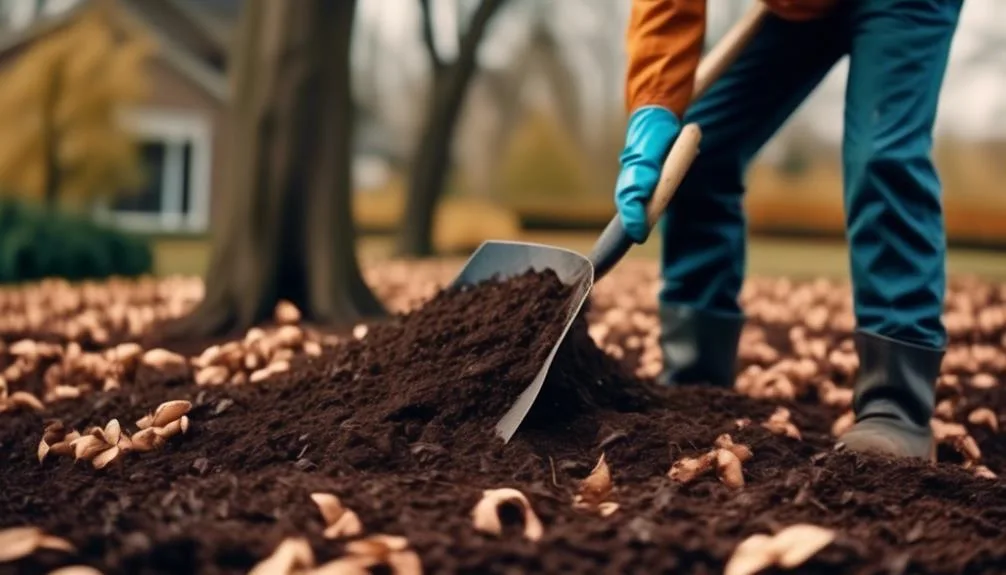Improving the soil for your dogwood trees can make a big difference in their health and growth. Simple techniques can create an environment that enhances their beauty.
Let's start with soil testing and analysis to understand the current condition and make necessary improvements for your beloved dogwoods.
Soil Testing and Analysis
Before planting dogwood trees, it's essential to conduct a thorough soil testing and analysis to ensure optimal growing conditions. Nutrient deficiencies can significantly impact the health and growth of dogwood trees.
A comprehensive soil test will reveal any deficiencies in essential nutrients such as nitrogen, phosphorus, and potassium, allowing you to address these issues before planting.
Furthermore, understanding the soil composition is crucial for determining the tree's ability to access these vital nutrients. Different soil types, such as sandy, loamy, or clay soils, can affect nutrient availability and water retention.
By analyzing the soil composition, you can make informed decisions about soil amendments and drainage improvements to create an ideal environment for your dogwood trees.
Taking these steps will lay a solid foundation for healthy and thriving dogwood trees in your landscape.
Adding Organic Matter
Once you've identified any nutrient deficiencies in your soil, the next step is to enhance its quality by adding organic matter to support the healthy growth of your dogwood trees. Adding organic matter can significantly improve the soil structure and provide essential nutrients for your trees. Here's how you can do it:
- Composting benefits: Utilize compost to enrich the soil with a variety of essential nutrients and beneficial microorganisms.
- Nutrient absorption: Organic matter improves the soil's ability to retain water and nutrients, allowing the dogwood trees to better absorb what they need for healthy growth.
- Mulching: Apply organic mulch around the base of the trees to conserve moisture, regulate soil temperature, and add nutrients as it decomposes.
- Cover cropping: Plant cover crops to protect the soil, suppress weeds, and add organic matter when they're eventually turned back into the soil.
Adjusting Ph Levels
To adjust the pH levels of your soil for optimal dogwood tree growth, consider incorporating elemental sulfur to lower pH or lime to raise pH as needed. Adjusting acidity levels can be achieved by applying sulfur, while altering alkalinity can be done through lime treatment. Here's a simple breakdown of the application rates for elemental sulfur and lime:
| Soil pH Level | Adjustment Needed | Elemental Sulfur (per 100 sq. ft.) | Lime (per 100 sq. ft.) |
|---|---|---|---|
| Below 5.5 | Raise pH | Not recommended | 5 pounds |
| 5.5-6.5 | Optimal range | Not needed | Not needed |
| Above 6.5 | Lower pH | 2 pounds | Not recommended |
Mulching Techniques
Consider using a layer of organic mulch around the base of your dogwood trees to help retain moisture, regulate soil temperature, and discourage weed growth. Mulching not only enhances the aesthetic appeal of your garden but also provides numerous benefits for your dogwood trees.
Here are some key points to keep in mind:
- Mulch application: Spread a 2- to 4-inch layer of mulch around the base of your dogwood trees, ensuring the mulch doesn't touch the trunk.
- Mulch benefits: Organic mulch helps to retain soil moisture, suppress weed growth, regulate soil temperature, and improve soil fertility.
- Mulching frequency: Replenish the mulch annually to maintain an adequate depth and reap the full benefits.
- Mulch type: Opt for organic mulch such as wood chips, shredded bark, or compost to provide essential nutrients as it decomposes.
Watering and Drainage
Enhancing the health of your dogwood trees involves not only mulching but also ensuring proper watering and drainage for optimal growth and vitality.
When it comes to watering, consider irrigation methods such as drip irrigation or soaker hoses, which deliver water directly to the roots, minimizing evaporation. This is especially important during the tree's establishment period.
Additionally, monitor soil compaction, as compacted soil can inhibit water penetration and root growth. To improve drainage, consider rainwater harvesting, which not only provides a sustainable water source but also reduces the load on municipal water systems. Implementing drainage solutions like French drains or grading the land away from the trees can also help prevent waterlogging.
Conclusion
By implementing these soil improvement techniques, your dogwood trees will thrive and add natural beauty to your garden.
Testing, adding organic matter, adjusting pH levels, mulching, and proper watering and drainage will create an optimal environment for their growth.
With care and attention to soil quality, your dogwood trees will flourish, becoming a vibrant centerpiece in your outdoor space.

My interest in trees started when I first saw the giant sequoias in Yosemite.
I was a teenager then, and I remember thinking, “I need to learn more about this.”
That moment stuck with me.
A few years later, I went on to study forestry at Michigan Tech.
Since graduating, I’ve worked in a mix of hands-on tree care and community education.
I’ve spent over ten years helping people understand how to plant, maintain, and protect the trees in their neighborhoods.
I don’t see trees as just part of the landscape.
They are living things that make a real difference in our daily lives.
